The GI-GPx gene is a target for Nrf2
- PMID: 15923610
- PMCID: PMC1140597
- DOI: 10.1128/MCB.25.12.4914-4923.2005
The GI-GPx gene is a target for Nrf2
Abstract
The gastrointestinal glutathione peroxidase (GI-GPx, GPx2) is a selenoprotein that was suggested to act as barrier against hydroperoxide absorption but has also been implicated in the control of inflammation and malignant growth. In CaCo-2 cells, GI-GPx was induced by t-butyl hydroquinone (tBHQ) and sulforaphane (SFN), i.e., "antioxidants" known to activate the "antioxidant response element" (ARE) via electrophilic thiol modification of Keap1 in the Nrf2/Keap1 system. The functional significance of a putative ARE in the GI-GPx promoter was validated by transcriptional activation of reporter gene constructs upon exposure to electrophiles (tBHQ, SFN, and curcumin) or overexpression of Nrf2 and by reversal of these effects by mutation of the ARE in the promoter and by overexpressed Keap1. Binding of Nrf2 to the ARE sequence in authentic gpx2 was corroborated by chromatin immunoprecipitation. Thus, the presumed natural antioxidants sulforaphane and curcumin may exert their anti-inflammatory and anticarcinogenic effects not only by induction of phase 2 enzymes but also by the up-regulation of the selenoprotein GI-GPx.
Figures


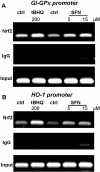
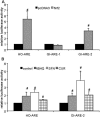
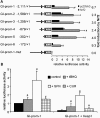
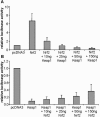
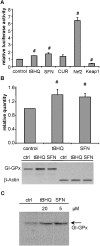
Similar articles
-
Transcriptional activation of the human Galphai2 gene promoter through nuclear factor-kappaB and antioxidant response elements.J Biol Chem. 2005 Mar 18;280(11):9786-95. doi: 10.1074/jbc.M414006200. Epub 2005 Jan 7. J Biol Chem. 2005. PMID: 15640523
-
Upregulating Nrf2-dependent antioxidant defenses in Pacific oysters Crassostrea gigas: Investigating the Nrf2/Keap1 pathway in bivalves.Comp Biochem Physiol C Toxicol Pharmacol. 2017 May;195:16-26. doi: 10.1016/j.cbpc.2017.02.004. Epub 2017 Feb 12. Comp Biochem Physiol C Toxicol Pharmacol. 2017. PMID: 28216009
-
Keap1 is a redox-regulated substrate adaptor protein for a Cul3-dependent ubiquitin ligase complex.Mol Cell Biol. 2004 Dec;24(24):10941-53. doi: 10.1128/MCB.24.24.10941-10953.2004. Mol Cell Biol. 2004. PMID: 15572695 Free PMC article.
-
The pathways and molecular mechanisms regulating Nrf2 activation in response to chemical stress.Free Radic Biol Med. 2004 Aug 15;37(4):433-41. doi: 10.1016/j.freeradbiomed.2004.04.033. Free Radic Biol Med. 2004. PMID: 15256215 Review.
-
Regulation of the Keap1/Nrf2 system by chemopreventive sulforaphane: implications of posttranslational modifications.Ann N Y Acad Sci. 2011 Jul;1229:184-9. doi: 10.1111/j.1749-6632.2011.06092.x. Ann N Y Acad Sci. 2011. PMID: 21793854 Review.
Cited by
-
Anti-cancer effects of curcumin on lung cancer through the inhibition of EZH2 and NOTCH1.Oncotarget. 2016 May 3;7(18):26535-50. doi: 10.18632/oncotarget.8532. Oncotarget. 2016. PMID: 27049834 Free PMC article.
-
Reduced mRNA expression levels of NFE2L2 are associated with poor outcome in breast cancer patients.BMC Cancer. 2016 Oct 22;16(1):821. doi: 10.1186/s12885-016-2840-x. BMC Cancer. 2016. PMID: 27770790 Free PMC article.
-
TrxR1 as a potent regulator of the Nrf2-Keap1 response system.Antioxid Redox Signal. 2015 Oct 1;23(10):823-53. doi: 10.1089/ars.2015.6378. Epub 2015 Jun 24. Antioxid Redox Signal. 2015. PMID: 26058897 Free PMC article. Review.
-
A combination of lipoic acid plus coenzyme Q10 induces PGC1α, a master switch of energy metabolism, improves stress response, and increases cellular glutathione levels in cultured C2C12 skeletal muscle cells.Oxid Med Cell Longev. 2012;2012:835970. doi: 10.1155/2012/835970. Epub 2012 May 9. Oxid Med Cell Longev. 2012. PMID: 22655115 Free PMC article.
-
Genome-wide analysis of human constitutive androstane receptor (CAR) transcriptome in wild-type and CAR-knockout HepaRG cells.Biochem Pharmacol. 2015 Nov 1;98(1):190-202. doi: 10.1016/j.bcp.2015.08.087. Epub 2015 Aug 12. Biochem Pharmacol. 2015. PMID: 26275810 Free PMC article.
References
-
- Alam, J., and J. L. Cook. 2003. Transcriptional regulation of the heme oxygenase-1 gene via the stress response element pathway. Curr. Pharm. Des. 9:2499-2511. - PubMed
-
- Ayabe, T., D. P. Satchell, C. L. Wilson, W. C. Parks, M. E. Selsted, and A. J. Ouellette. 2000. Secretion of microbicidal alpha-defensins by intestinal Paneth cells in response to bacteria. Nat. Immunol. 1:113-118. - PubMed
-
- Banning, A., K. Schnurr, G. F. Böl, D. Kupper, K. Müller-Schmehl, H. Viita, S. Yla-Herttuala, and R. Brigelius-Flohé. 2004. Inhibition of basal and interleukin-1-induced VCAM-1 expression by phospholipid hydroperoxide glutathione peroxidase and 15-lipoxygenase in rabbit aortic smooth muscle cells. Free Radic. Biol. Med. 36:135-144. - PubMed
-
- Bierl, C., B. Voetsch, R. C. Jin, D. E. Handy, and J. Loscalzo. 2004. Determinants of human plasma glutathione peroxidase (GPx-3) expression. J. Biol. Chem. 279:26839-26845. - PubMed
-
- Böcher, M., T. Böldicke, M. Kiess, and U. Bilitewski. 1997. Synthesis of mono- and bifunctional peptide-dextran conjugates for the immobilization of peptide antigens on ELISA plates: properties and application. J. Immunol. Methods 208:191-202. - PubMed
Publication types
MeSH terms
Substances
LinkOut - more resources
Full Text Sources
Research Materials
Miscellaneous
